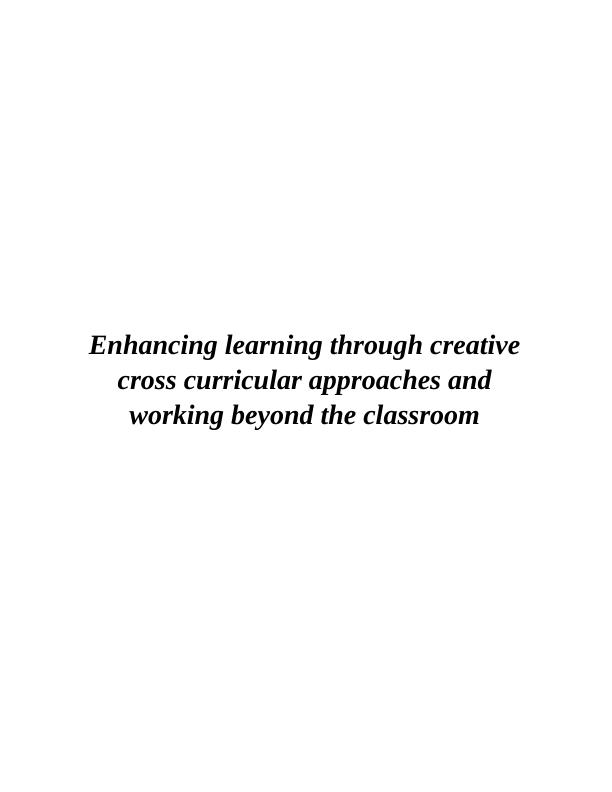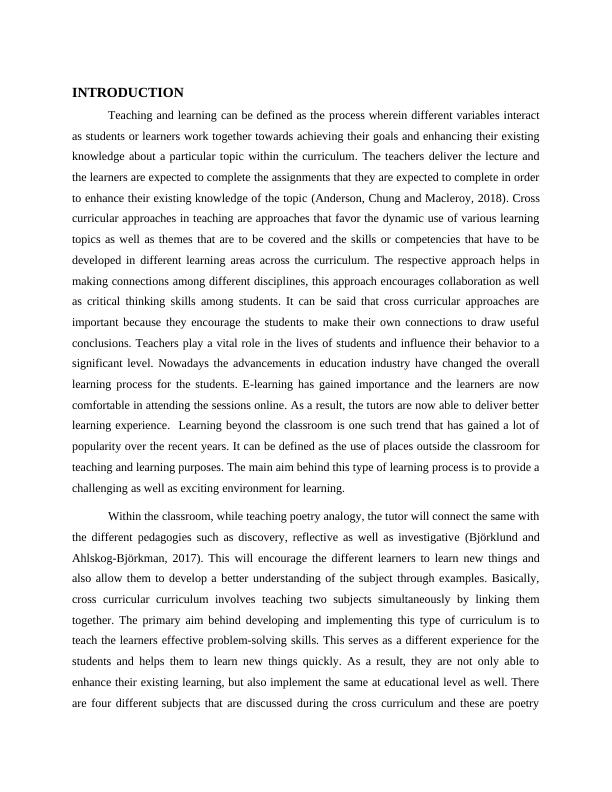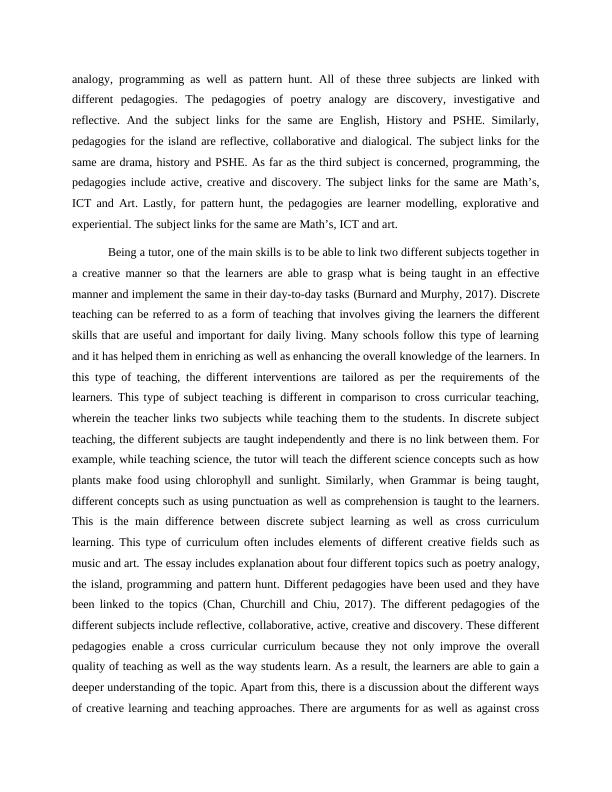Enhancing Learning through Creative Cross Curricular Approaches
14 Pages5229 Words3 Views
Added on 2022-12-26
About This Document
This article explores the benefits of cross curricular approaches in enhancing learning and working beyond the classroom. It discusses the concept of online teaching and its limitations in cross curricular teaching.
Enhancing Learning through Creative Cross Curricular Approaches
Added on 2022-12-26
ShareRelated Documents
Enhancing learning through creative
cross curricular approaches and
working beyond the classroom
cross curricular approaches and
working beyond the classroom

Contents
INTRODUCTION.....................................................................................................................................3
MAIN BODY.............................................................................................................................................6
CONCLUSION........................................................................................................................................11
REFERENCES........................................................................................................................................13
INTRODUCTION.....................................................................................................................................3
MAIN BODY.............................................................................................................................................6
CONCLUSION........................................................................................................................................11
REFERENCES........................................................................................................................................13

INTRODUCTION
Teaching and learning can be defined as the process wherein different variables interact
as students or learners work together towards achieving their goals and enhancing their existing
knowledge about a particular topic within the curriculum. The teachers deliver the lecture and
the learners are expected to complete the assignments that they are expected to complete in order
to enhance their existing knowledge of the topic (Anderson, Chung and Macleroy, 2018). Cross
curricular approaches in teaching are approaches that favor the dynamic use of various learning
topics as well as themes that are to be covered and the skills or competencies that have to be
developed in different learning areas across the curriculum. The respective approach helps in
making connections among different disciplines, this approach encourages collaboration as well
as critical thinking skills among students. It can be said that cross curricular approaches are
important because they encourage the students to make their own connections to draw useful
conclusions. Teachers play a vital role in the lives of students and influence their behavior to a
significant level. Nowadays the advancements in education industry have changed the overall
learning process for the students. E-learning has gained importance and the learners are now
comfortable in attending the sessions online. As a result, the tutors are now able to deliver better
learning experience. Learning beyond the classroom is one such trend that has gained a lot of
popularity over the recent years. It can be defined as the use of places outside the classroom for
teaching and learning purposes. The main aim behind this type of learning process is to provide a
challenging as well as exciting environment for learning.
Within the classroom, while teaching poetry analogy, the tutor will connect the same with
the different pedagogies such as discovery, reflective as well as investigative (Björklund and
Ahlskog-Björkman, 2017). This will encourage the different learners to learn new things and
also allow them to develop a better understanding of the subject through examples. Basically,
cross curricular curriculum involves teaching two subjects simultaneously by linking them
together. The primary aim behind developing and implementing this type of curriculum is to
teach the learners effective problem-solving skills. This serves as a different experience for the
students and helps them to learn new things quickly. As a result, they are not only able to
enhance their existing learning, but also implement the same at educational level as well. There
are four different subjects that are discussed during the cross curriculum and these are poetry
Teaching and learning can be defined as the process wherein different variables interact
as students or learners work together towards achieving their goals and enhancing their existing
knowledge about a particular topic within the curriculum. The teachers deliver the lecture and
the learners are expected to complete the assignments that they are expected to complete in order
to enhance their existing knowledge of the topic (Anderson, Chung and Macleroy, 2018). Cross
curricular approaches in teaching are approaches that favor the dynamic use of various learning
topics as well as themes that are to be covered and the skills or competencies that have to be
developed in different learning areas across the curriculum. The respective approach helps in
making connections among different disciplines, this approach encourages collaboration as well
as critical thinking skills among students. It can be said that cross curricular approaches are
important because they encourage the students to make their own connections to draw useful
conclusions. Teachers play a vital role in the lives of students and influence their behavior to a
significant level. Nowadays the advancements in education industry have changed the overall
learning process for the students. E-learning has gained importance and the learners are now
comfortable in attending the sessions online. As a result, the tutors are now able to deliver better
learning experience. Learning beyond the classroom is one such trend that has gained a lot of
popularity over the recent years. It can be defined as the use of places outside the classroom for
teaching and learning purposes. The main aim behind this type of learning process is to provide a
challenging as well as exciting environment for learning.
Within the classroom, while teaching poetry analogy, the tutor will connect the same with
the different pedagogies such as discovery, reflective as well as investigative (Björklund and
Ahlskog-Björkman, 2017). This will encourage the different learners to learn new things and
also allow them to develop a better understanding of the subject through examples. Basically,
cross curricular curriculum involves teaching two subjects simultaneously by linking them
together. The primary aim behind developing and implementing this type of curriculum is to
teach the learners effective problem-solving skills. This serves as a different experience for the
students and helps them to learn new things quickly. As a result, they are not only able to
enhance their existing learning, but also implement the same at educational level as well. There
are four different subjects that are discussed during the cross curriculum and these are poetry

analogy, programming as well as pattern hunt. All of these three subjects are linked with
different pedagogies. The pedagogies of poetry analogy are discovery, investigative and
reflective. And the subject links for the same are English, History and PSHE. Similarly,
pedagogies for the island are reflective, collaborative and dialogical. The subject links for the
same are drama, history and PSHE. As far as the third subject is concerned, programming, the
pedagogies include active, creative and discovery. The subject links for the same are Math’s,
ICT and Art. Lastly, for pattern hunt, the pedagogies are learner modelling, explorative and
experiential. The subject links for the same are Math’s, ICT and art.
Being a tutor, one of the main skills is to be able to link two different subjects together in
a creative manner so that the learners are able to grasp what is being taught in an effective
manner and implement the same in their day-to-day tasks (Burnard and Murphy, 2017). Discrete
teaching can be referred to as a form of teaching that involves giving the learners the different
skills that are useful and important for daily living. Many schools follow this type of learning
and it has helped them in enriching as well as enhancing the overall knowledge of the learners. In
this type of teaching, the different interventions are tailored as per the requirements of the
learners. This type of subject teaching is different in comparison to cross curricular teaching,
wherein the teacher links two subjects while teaching them to the students. In discrete subject
teaching, the different subjects are taught independently and there is no link between them. For
example, while teaching science, the tutor will teach the different science concepts such as how
plants make food using chlorophyll and sunlight. Similarly, when Grammar is being taught,
different concepts such as using punctuation as well as comprehension is taught to the learners.
This is the main difference between discrete subject learning as well as cross curriculum
learning. This type of curriculum often includes elements of different creative fields such as
music and art. The essay includes explanation about four different topics such as poetry analogy,
the island, programming and pattern hunt. Different pedagogies have been used and they have
been linked to the topics (Chan, Churchill and Chiu, 2017). The different pedagogies of the
different subjects include reflective, collaborative, active, creative and discovery. These different
pedagogies enable a cross curricular curriculum because they not only improve the overall
quality of teaching as well as the way students learn. As a result, the learners are able to gain a
deeper understanding of the topic. Apart from this, there is a discussion about the different ways
of creative learning and teaching approaches. There are arguments for as well as against cross
different pedagogies. The pedagogies of poetry analogy are discovery, investigative and
reflective. And the subject links for the same are English, History and PSHE. Similarly,
pedagogies for the island are reflective, collaborative and dialogical. The subject links for the
same are drama, history and PSHE. As far as the third subject is concerned, programming, the
pedagogies include active, creative and discovery. The subject links for the same are Math’s,
ICT and Art. Lastly, for pattern hunt, the pedagogies are learner modelling, explorative and
experiential. The subject links for the same are Math’s, ICT and art.
Being a tutor, one of the main skills is to be able to link two different subjects together in
a creative manner so that the learners are able to grasp what is being taught in an effective
manner and implement the same in their day-to-day tasks (Burnard and Murphy, 2017). Discrete
teaching can be referred to as a form of teaching that involves giving the learners the different
skills that are useful and important for daily living. Many schools follow this type of learning
and it has helped them in enriching as well as enhancing the overall knowledge of the learners. In
this type of teaching, the different interventions are tailored as per the requirements of the
learners. This type of subject teaching is different in comparison to cross curricular teaching,
wherein the teacher links two subjects while teaching them to the students. In discrete subject
teaching, the different subjects are taught independently and there is no link between them. For
example, while teaching science, the tutor will teach the different science concepts such as how
plants make food using chlorophyll and sunlight. Similarly, when Grammar is being taught,
different concepts such as using punctuation as well as comprehension is taught to the learners.
This is the main difference between discrete subject learning as well as cross curriculum
learning. This type of curriculum often includes elements of different creative fields such as
music and art. The essay includes explanation about four different topics such as poetry analogy,
the island, programming and pattern hunt. Different pedagogies have been used and they have
been linked to the topics (Chan, Churchill and Chiu, 2017). The different pedagogies of the
different subjects include reflective, collaborative, active, creative and discovery. These different
pedagogies enable a cross curricular curriculum because they not only improve the overall
quality of teaching as well as the way students learn. As a result, the learners are able to gain a
deeper understanding of the topic. Apart from this, there is a discussion about the different ways
of creative learning and teaching approaches. There are arguments for as well as against cross

End of preview
Want to access all the pages? Upload your documents or become a member.
Related Documents
Leading for Change in Curriculum and Pedagogylg...
|15
|4058
|76
Microteaching and Reflection Assessment 3lg...
|11
|1183
|349
Pedagogy Methods in Higher Educationlg...
|9
|1716
|223
Lesson Planning: Characteristics, Aims, and Guidance on Assessment and Evaluationlg...
|17
|5030
|374
Education Pedagogy: Case Study of Mrs. Edwardlg...
|7
|1582
|26
Teaching in a Specialist Arealg...
|15
|3177
|41
